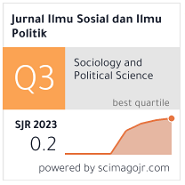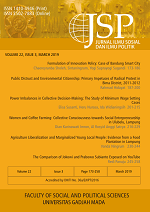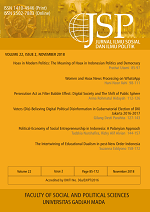A Big Battle: The State vs. Indigenous People (Case Study in Jambi Province)
M. Yusuf(1*), Syafrial Syafrial(2)
(1) Department of Government Studies, Universitas Jambi
(2) Department of Government Studies, STISIP Nurdin Hamzah
(*) Corresponding Author
Abstract
The change in designation of Bukit Duabelas area into Bukit Duabelas National Park in Jambi province raises a conflict between the national park official who was ruling the zonation system in the national park and the Orang Rimba people who have lived there for many years. The decision of the protected area aims to preserve the life and culture of Orang Rimba. However, zoning rules in the field are interpreted as an effort to limit space and access to the forest resources for Orang Rimba who have traditionally utilized them. This research uses a case study approach to explore the dynamics of conflict on the protected area. The results of the study show that conflicts in national park management are very dynamic because of shifting disagreement about the protection area. The conflicts began with debates about the zoning system which led into the fight for access to the park resources which were contested over the concept of national parks and customary forests. This paper argues the battle over the national park was not only about contested natural resources but also was a fight for authority and power between the state and indigenous people over the concept of park management.
Keywords
Full Text:
PDFReferences
Afiff, S., & Low e, C.(2007). Claiming indigenous community: Political discourse and natural resources right in Indonesia. Alternatives, 32, 73–79. doi: 10.1177%2F030437540703200104
Agung, P. (2011). Rencana tata ruang wilayah dan distribusi manfaat sumberdaya hutan. World Agroforestry Centre, (12), 1–4.
Anjarwati, E. (2008). Mainstreaming local wisdom: Indigenous people collective action in ainforest management (The Case of Indonesia and Philippines), 1–16. Retrieved from http://iasc2008. glos.ac.uk/conference papers/papers/A/ Anjarwati_207101.pdf
Balai Taman Nasional Bukit Duabelas. (2009). Laporan Sosialisasi dan Konsultasi Publik Penempatan Zonasi Taman Nasional Bukit Duabelas (Rep.). Jambi, Indonesia. Balai Taman Nasional Bukit Duabelas.
Bakker, L., & Moniaga, S. (2010). The space between: Land claims and the law in Indonesia. Asian Journal of Social Science, 38, 187–203. doi: 10.1163/156853110X490890
Beckert, B., Dittrich, C., & Adiwibowo, S. (2014). Contested land: An analysis of multi-layered conflicts in Jambi Province, Sumatra, Indonesia. ASEAS – Austrian Journal of South-East Asian Studies, 7(1), 75–92. doi: 10.14764/10.ASEAS-2014.1-6
Cote, D. J., & Cliche, L. (2011). Indigenous peoples’ resistance to oil palm plantation in Borneo. Kasarinlan: Philippine Journal of Third World Studies, 26(1–2), 121–152.
Darmanto. (2011). Konservasi global, taman nasional dan praktek lokal di pulau Siberut, Sumatera Barat. Jurnal Ilmu Kehutanan, V(1), 52–65. doi: 10.22146/ jik.582
Drahmoune, F. (2013). Agrarian transitions, rural resistance and peasant politics in Southeast Asia. Journal of Current Southeast Asian Affairs, 32(1), 111–139. doi: 10.1177/186810341303200105
Hammill, A., Craig, R., Malpas, R., & Matthew, R. (2009). Conflict-Sesitive conservation practitioners’ manual. Manitoba, Canada: International Institute for Sustainable Development.
Harun, M. K., & Dwiprabowo, H. (2014). Model resolusi konflik lahan di kesatuan hutan produksi model Banjar. Jurnal Penelitian Sosial dan Ekonomi Kehutanan, 11(4), 265– 280. doi: 10.20886/jakk.2014.11.1.71-90
Constitution of the Republic Indonesia. (1999). Kehutanan (No. 41/1999). Indonesia: House of Representatives.
Jemahat, L., & Si, P. K. (2018). Dinamika konflik sosial berakar tanah komunal di kabupaten Manggarai Flores. Sosio Konsepsia, 8(01), 45–59. doi: 10.33007/ska. v8i1.1544
KomnasHAM. (2007). Laporan akhir pemantauan dugaan pelanggaran hak masyarakat adat Orang Rimba. Jakarta: KomnasHAM.
Kusworo, A. (2014). Resource control, conflict, and collaboration. In A. Kusworo (Ed.), Pursuing livelihoods, imagining development (pp. 93–109). Australia: ANU Press.
Larson, A. M. (2013). Hak Tenurial dan akses ke hutan manual pelatihan untuk penelitian. Bogor, Indonesia: CIFOR.
Marina, I., & Dharmawan, A. H. (2011). Analisis konflik sumberdaya hutan di kawasan konservasi. Sodality: Jurnal Transdisiplin Sosiologi, Komunikasi, Dan Ekologi Manusia, 05(01), 90–96. doi: 10.22500/sodality.v5i1.5830
Matland, R. E. (1995). Synthes izing the Implementation literature: The ambiguity- conflict model of policy implementation. Journal of Public Administration Research and Theory: J-PART, 5(2), 145–174. doi: 10.1093/oxfordjournals.jpart.a037242
Prabowo, S. A., Basuni, S., & Suharjito, D. (2010). Konflik tanpa henti: Permukiman dalam kawasan taman nasional halimun salak. Jurnal Manajemen Hutan Tropika, XVI(3), 137–142.
Pruitt, D. G., & Rubin, J. Z. (2004). Teori konflik sosial. Yogyakarta: Pustaka Pelajar.
Purnomo, E. P., & Anand, P.(2014). The conflict of forest tenure and the emergence of community based forest management in Indonesia. Jurna l of Go vernm ent and Politics, 5(1), 20–31. doi: 10.18196/ jgp.2014.0003
Ribot, J. C., & Peluso, N. L. (2003). A theory of access. Rural Sociology, 68(2), 153–181. doi: 10.1111/j.1549-0831.2003.tb00133.x
Rokhdian, D. (2012). Alim Rajo disembah, piado alim rajo disanggah: Ragam bentuk perlawanan orang rimba makekal hulu terhadap kebijakan zonasi Taman Nasional Bukit Duabelas, Jambi (Unpublished master’s thesis). Universitas Indonesia.
Sardi, I. (2010). Konflik sosial dalam pemanfaatan sumberdaya hutan (Study kasus di taman Nasional Bukit DuaBelas Provinsi Jambi) (Unpublished master’s thesis). Institut Pertanian Bogor
Sembiring, E., Basuni, S., & Soekmadi, R. (2010). Resolusi konflik pengelolaan Taman Nasional Teluk Cenderawasih di Kabupaten Teluk Wondama. Jurnal Manajemen Hutan Tropika, XVI (2)(2), 84–91.
Senjaya, B. (2011). Resistensi orang rimba (Studi tentang perlawanan Orang Rimba menghadapi kebijakan rencana pengelolaan Taman Nasional Bukit Duabelas Propinsi Jambi) (Unpublished master’s thesis). Universitas Gadjah Mada.
Stark, S., & Torrance, H. (2005). Case study. In B. Somekh & C. Lewin (Eds.), Research Methods in the Social Sciences (1st ed., pp. 33–40). London, New Delhi: SAGE Publications.
Steinebach, S. (2013). “Today we Occupy the Plantation-Tomorrow Jakarta”: Indigeneity, Land and Oil P alm Plantations in Jambi. In B. Hauser- Schäublin (Ed.), Adat and Indigeneity in Indonesia: Culture and Entitlements between Heteronomy and Self-Ascription (pp. 63–79). Göttingen: Universitätsverlag Göttingen.
Steinebach, S., & Kunz, Y. (2017). Separating sisters from brothers: Ethnic relations and identity politics in the context of indigenous land Titling in Indonesia. Austrian Journal of South-East Asian Studies, 10(1), 47–64. doi:10.14764/10.ASEAS-2017.1-4
Susan, N. (2009). Sosiologi Konflik dan Isu-isu Kontemporer. Jakarta: Kencana.
Sylviani. (2008). Kajian dampak perubahan fung si kaw asan hut an t erhadap masyarkat sekitar. Penelitian Sosial dan Ekonomi Kehutanan, 5(3), 155–178. doi: 10.20886/jpsek.2008.5.3.155-178
Takiddin. (2014). Nilai-nilai kearifan budaya lokal orang rimba (Studi pada suku minoritas rimba di Kecamatan Air Hitam Provinsi Jambi). Jurnal Sosio Didaktika, 1(2), 161–170. doi: 10.15408/sd.v1i2.1258
Veeger, K. J. (1990). Realitas sosial, reflekasi filsafat sosial atas hubungan individu-masyarakat dalam cakrawala sejarah sosiologi. Jakarta: Gramedia.
Yasmi, Y., Guernier, J., & Colfer, C. J. (2009). Positive and negative aspects of forestry conflict: Lessons From a decentralized forest management in Indonesia. International Forestry Review, 11(1), 98–110. doi: 10.1505/ifor.11.1.98
Yasmi, Y., Kelley, L., & Enters, T. (2011). Forest conflict in Asia and the role of collective Action in its management. Communications, (102), 30. doi: 10.2499/CAPRiWP102.
Article Metrics
Refbacks
- There are currently no refbacks.
Copyright (c) 2019 Jurnal Ilmu Sosial dan Ilmu Politik

This work is licensed under a Creative Commons Attribution-NonCommercial-NoDerivatives 4.0 International License.






















